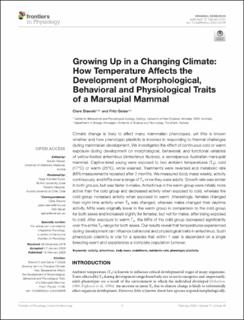| dc.contributor.author | Stawski, Clare | |
| dc.contributor.author | Geiser, Fritz | |
| dc.date.accessioned | 2020-04-08T07:52:27Z | |
| dc.date.available | 2020-04-08T07:52:27Z | |
| dc.date.created | 2020-04-07T11:55:17Z | |
| dc.date.issued | 2020 | |
| dc.identifier.citation | Frontiers in Physiology. 2020, 11 49-?. | en_US |
| dc.identifier.issn | 1664-042X | |
| dc.identifier.uri | https://hdl.handle.net/11250/2650725 | |
| dc.description.abstract | Climate change is likely to affect many mammalian phenotypes, yet little is known whether and how phenotypic plasticity is involved in responding to thermal challenges during mammalian development. We investigated the effect of continuous cold or warm exposure during development on morphological, behavioral, and functional variables of yellow-footed antechinus (Antechinus flavipes), a semelparous Australian marsupial mammal. Captive-bred young were exposed to two ambient temperatures (Ta), cold (17°C) or warm (25°C), once weaned. Treatments were reversed and metabolic rate (MR) measurements repeated after 2 months. We measured body mass weekly, activity continuously, and MRs over a range of Ta once they were adults. Growth rate was similar in both groups, but was faster in males. Antechinus in the warm group were initially more active than the cold group and decreased activity when exposed to cold, whereas the cold group increased activity when exposed to warm. Interestingly, females changed their night-time activity when Ta was changed, whereas males changed their daytime activity. MRs were originally lower in the warm group in comparison to the cold group for both sexes and increased slightly for females, but not for males, after being exposed to cold. After exposure to warm Ta, the MRs of the cold group decreased significantly over the entire Ta-range for both sexes. Our results reveal that temperatures experienced during development can influence behavioral and physiological traits in antechinus. Such phenotypic plasticity is vital for a species that within 1 year is dependent on a single breeding event and experiences a complete population turnover. | en_US |
| dc.language.iso | eng | en_US |
| dc.publisher | Frontiers Media | en_US |
| dc.relation.uri | https://www.frontiersin.org/articles/10.3389/fphys.2020.00049/full?utm_source=fweb&utm_medium=nblog&utm_campaign=ba-sci-fphys-marsupial-development-climate | |
| dc.rights | Navngivelse 4.0 Internasjonal | * |
| dc.rights.uri | http://creativecommons.org/licenses/by/4.0/deed.no | * |
| dc.title | Growing up in a changing climate: how temperature affects the development of morphological, behavioral and physiological traits of a marsupial mammal | en_US |
| dc.type | Peer reviewed | en_US |
| dc.type | Journal article | en_US |
| dc.description.version | publishedVersion | en_US |
| dc.source.pagenumber | 49-? | en_US |
| dc.source.volume | 11 | en_US |
| dc.source.journal | Frontiers in Physiology | en_US |
| dc.identifier.doi | 10.3389/fphys.2020.00049 | |
| dc.identifier.cristin | 1805544 | |
| dc.description.localcode | Copyright © 2020 Stawski and Geiser. This is an open-access article distributed under the terms of the Creative Commons Attribution License (CC BY). The use, distribution or reproduction in other forums is permitted, provided the original author(s) and the copyright owner(s) are credited and that the original publication in this journal is cited, in accordance with accepted academic practice. No use, distribution or reproduction is permitted which does not comply with these terms. | en_US |
| cristin.ispublished | true | |
| cristin.fulltext | original | |
| cristin.qualitycode | 1 | |

